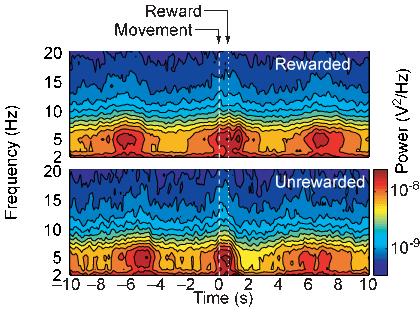Recent evidence has suggested that theta-frequency (4-7 Hz) oscillations around the human anterior cingulate cortex (ACC) and frontal cortex, namely frontal midline theta (Fm theta) oscillations, may be involved in attentional processes in the brain. However, little is known about the physiological basis of Fm theta oscillations, as invasive study in the human is allowed only in limited cases. In the present study, we developed a monkey model for Fm theta oscillations and located the generators of theta waves using electrodes implanted in various cortical areas. Monkeys were engaged in a self-initiated hand movement task with a waiting period. The theta power in area 9 (the medial prefrontal cortex) and area 32 (the rostral ACC) was gradually increased from a few seconds before the movement and reached a peak immediately after the movement. When the movement was rewarded, the theta power attained a second peak, while it swiftly decreased in the unrewarded trials. Theta oscillations in areas 9 and 32 were coherent and phase-locked together. This theta activity may be associated with 'executive attention' including self-control, internal timing, and assessment of reward. It is probably a homologue of human Fm theta oscillations, as judged from the similar localization, corresponding frequency, and dependence on attentional processes. The monkey model would be useful for studying executive functions in the frontal cortex.
Tsujimoto T, Shimazu H, Isomura Y,
Direct recording of theta oscillations in primate prefrontal and anterior cingulate cortices.
J Neurophysiol 95(5): 2987-3000, 2006

Representative data recorded in area 9. The monkey was engaged in a self-initiated hand movement task with a waiting period. When the monkey kept holding the lever in the resting position for more than a fixed waiting period before lifting the lever, the movement was rewarded. The theta power was gradually increased from a few seconds before the movement and reached a peak immediately after the movement. When the movement was rewarded, the theta power attained a second peak, while it swiftly decreased in the unrewarded trials.